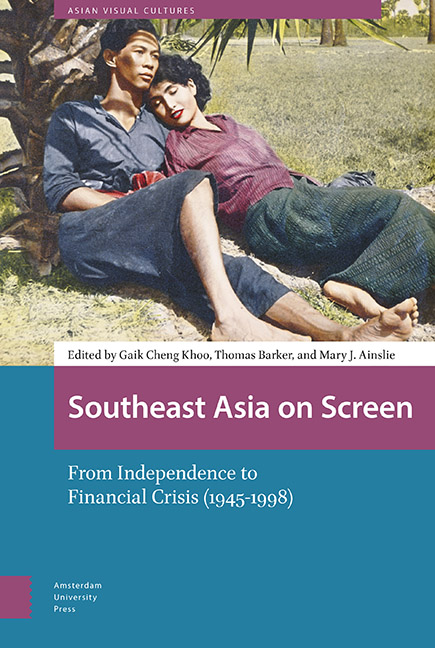Book contents
- Frontmatter
- Contents
- List of Illustrations
- Introduction: Southeast Asia on Screen: From Independence to Financial Crisis (1945–1998)
- Section 1 Independence and Post-World War II Filmmaking: Nation-building, Modernity and Golden Eras
- Section 2 Key Directors
- Section 3 Popular Pleasures
- About the Authors
- Index
3 - Pearl Tears on the Silver Screen: War Movies and Expanding Burmese Militarism in the Early Independence Years
Published online by Cambridge University Press: 20 November 2020
- Frontmatter
- Contents
- List of Illustrations
- Introduction: Southeast Asia on Screen: From Independence to Financial Crisis (1945–1998)
- Section 1 Independence and Post-World War II Filmmaking: Nation-building, Modernity and Golden Eras
- Section 2 Key Directors
- Section 3 Popular Pleasures
- About the Authors
- Index
Summary
Abstract
The early years of Burmese postcolonial independence (1948) saw a tremendous expansion of the Tatmadaw (Burmese Armed Forces) predicated on an ongoing civil war and the Kuomintang ‘incursion’ in the northeastern Shan State. The same years comprised the beginning of the so-called ‘golden age’ of Burmese cinema. Amidst films of various genres, historical fiction war films glorifying Burmese soldiers and peasants as heroes, and constructing archetypes of enemies to the country's independence marked an important shift from earlier colonial-era nationalist films which had sought to reclaim Burmese sovereignty by harking back to the grandeur of prior Burmese dynasties. Instead, while war experiences are homogenized and enemies are stereotyped, national heroes were now created as part of a post-independence political milieu.
Keywords: Burma, war films, nation-building, Cold War
‘When the war is over, I will come back to you,’ Seya Kyaw assures his village sweetheart, Ama. The young woman, in tears, responds to her soldier lover, ‘I promise, we will be together.’ And with these sad, but hopeful words the final scene of the 1962 Burmese war drama, PULE MYIT YEE (Pearl Tears, Kyaw Swe), henceforth referred to as PEARL TEARS, is brought to a close. Loosely based on the plot of the Ernest Hemingway novel set during the Spanish Civil War, For Whom the Bell Tolls (1940), PEARL TEARS depicts the travails of platoons of the Burmese Army, the Tatmadaw, as they are despatched into territory held by the invading Kuomintang or tayoukpyu ‘white Chinese’ during the 1950s.
Although the political role of the Tatmadaw is explicit following General Ne Win's coup and subsequent Revolutionary Council, later Burmese Socialist Programme Party, regimes, the fourteen years between independence in 1948 and Ne Win's coup in 1962 comprised the period in which the Tatmadaw expanded and consolidated its power. The very same period coincided with significant government investment in and a major flourishing of the Burmese motion picture industry.
With postcolonial independence in the aftermath of World War II came new ideological directives, stressing national unity in the context of the country's ongoing internal conflict. As such, the Burmese culture industries were selectively tasked with two related ideological projects: to laud the Tatmadaw as the key to the establishment (and protection) of an ethnically united, newly independent nation; and to characterize the enemies of that national project, presenting those enemies in the form of threatening foreigners, be they soldiers or capitalists.
- Type
- Chapter
- Information
- Southeast Asia on ScreenFrom Independence to Financial Crisis (1945–1998), pp. 75 - 92Publisher: Amsterdam University PressPrint publication year: 2020



